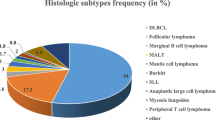Abstract
We sought to determine the frequency of primary extranodal lymphoma (ENL) and its characteristics in Kanagawa, a human T-cell leukemia virus type 1 (HTLV-1) nonendemic area in Japan. Subjects were 847 newly diagnosed patients with malignant lymphoma at the Yokohama City University Hospital and 8 affiliated hospitals mainly located in Kanagawa prefecture from 1999 to 2005. We compared the clinicopathological characteristics of primary ENL with primary nodal lymphoma (NL). Histological specimens were evaluated according to the World Health Organization classifications. A total of 395 (46.6%) and 452 (53.4%) patients had primary ENL and primary NL, respectively. The frequency of primary ENL increased with age. Primary extranodal sites included the gastrointestinal tract (30.4%), Waldeyer’s ring (17.8%), orbits (7.0%), soft tissue and subcutaneous tissue (5.2%), bone (4.6%), skin (4.3%), thyroid gland (4.3%), testis and prostate (3.3%), bone marrow (3.3%), nasal and paranasal cavities (2.6%), salivary glands (2.3%), lung and pleura (2.0%), breast (1.8%), central nervous system (1.0%), uterus and ovary (0.5%), and others (9.8%). Among the 395 cases of primary ENL, diffuse large B-cell lymphoma (61.2%) was most frequently diagnosed, followed by extranodal marginal zone B-cell lymphoma of mucosa-associated lymphoid tissue (13.3%) and follicular lymphoma (5.6%). The frequency of primary ENL is approximately 50% of the total lymphoma cases in Kanagawa, an HTLV-1 nonendemic area in Japan. This frequency appears to be higher than that in Western countries.

Similar content being viewed by others
References
Carbone PP, Kaplan HS, Musshoff K, Smithers DW, Tubiana M. Report of the Committee on Hodgkin’s Disease Staging Classification. Cancer Res. 1971;31:1860–1.
Jaffe ES, Harris NL, Stein H, Vardiman JW. Pathology and genetics of tumours of haematopoietic and lymphoid tissues. World Health Organization Classification of Tumours. Lyon: IARC Press; 2001.
A predictive model for aggressive non-Hodgkin’s lymphoma: the International Non-Hodgkin’s Lymphoma Prognostic Factors Project. N Engl J Med. 1993;329:987–94. doi:10.1056/NEJM199309303291402.
Freeman C, Berg JW, Cutler SJ. Occurrence and prognosis of extranodal lymphomas. Cancer. 1972;29:252–60. doi:10.1002/1097-0142(197201)29:1≤252::AID-CNCR2820290138≥3.0.CO;2-#.
Sutcliff SB, Gospodarowicz MK. Clinical features and management of localized extranodal lymphomas. In: Keating A, Armitage J, Burnet A, Newland A, editors. Haematological oncology, vol 2. Cambridge: Cambridge University Press; 1992. p. 189–223.
Ahmad M, Malik IA. Non-Hodgkin’s lymphoma in developing countries. In: Magrath IT, editor. The Non-Hodgkin’s lymphomas, 2nd ed. London: Arnold; 1997. p. 1031–54.
d’Amore F, Christensen BE, Brincker H. Clinicopathological features and prognostic factors in extranodal non-Hodgkin’s lymphomas. Danish LYFO Study Group. Eur J Cancer. 1991;27:1201–8.
Otter R, Gerrits WB, Sandt MMVD, Hermans J, Willemze R. Primary extranodal and nodal non-Hodgkin’s lymphoma. A survey of a population-based registry. Eur J Cancer Clin Oncol. 1989;25:1203–10. doi:10.1016/0277-5379(89)90416-1.
Takagi T. Clinical features of extranodal malignant lymphoma—staging classification and treatment strategies. Rinsho Ketsueki. 1999;40:188–91.
Nitsu N, Okamoto M. Activities and analysis. In: Adult lymphoma treatment study group, editors. Malignant lymphoma clinical and pathology. Tokyo: Sentan-igakusha; 2005. p. 14–28.
Zucca E, Roggero E, Bertoni F, Conconi A, Cavalli F. Primary extranodal non-Hodgkin’s lymphomas. Part 2: head and neck, central nervous system and other less common sites. Ann Oncol. 1999;10:1023–33. doi:10.1023/A:1008313229892.
Moller MB, Pedersen NT, Christensen BE. Diffuse large B-cell lymphoma: clinical implications of extranodal versus nodal presentation—a population-based study of 1575 cases. Br J Haematol. 2004;124:151–9. doi:10.1046/j.1365-2141.2003.04749.x.
Devesa SS, Fears T. Non-Hodgkin’s lymphoma time trends: United States and international data. Cancer Res. 1992;52:5432s–40s.
Groves FD, Linet MS, Travis LB, Devesa SS. Cancer surveillance series: non-Hodgkin’s lymphoma incidence by histologic subtype in the United States from 1978 through 1995. J Natl Cancer Inst. 2000;92:1240–51. doi:10.1093/jnci/92.15.1240.
Zucca E, Roggero E, Bertoni F, Cavalli F. Primary extranodal non-Hodgkin’s lymphomas. Part 1: gastrointestinal, cutaneous and genitourinary lymphomas. Ann Oncol. 1997;8:727–37. doi:10.1023/A:1008282818705.
Weisenburger DD. Epidemiology of non-Hodgkin’s lymphoma: recent findings regarding an emerging epidemic. Ann Oncol. 1994;5:19s–24s.
Levine PH, Hoover RN. The emerging epidemic of non-Hodgkin’s lymphoma: current knowledge regarding aetiologic factors. Cancer Res. 1992;52:5425s–574s.
Xu WS, Ho FC, Ho J, Chan AC, Srivastava G. Pathogenesis of gastric lymphoma: the enigma in Hong Kong. Ann Oncol. 1997;8:41–4. doi:10.1023/A:1008265829249.
Luppi M, et al. Additional neoplasms and HCV infection in low-grade lymphoma of MALT type. Br J Haematol. 1996;94:373–5. doi:10.1046/j.1365-2141.1996.d01-1791.x.
López-Guillermo A, et al. Diffuse large B-cell lymphoma: clinical and biological characterization and outcome according to the nodal or extranodal primary origin. J Clin Oncol. 2005;23:2797–804. doi:10.1200/JCO.2005.07.155.
Bogomolski-Yahalom V, et al. Intravascular lymphomatosis—an indolent or aggressive entity? Leuk Lymphoma. 1998;29:585–93. doi:10.3109/10428199809050918.
Acknowledgment
We thank Dr. Juichi Tanabe for collecting clinical data from Fujieda Municipal General Hospital.
Author information
Authors and Affiliations
Corresponding author
Rights and permissions
About this article
Cite this article
Fujita, A., Tomita, N., Fujita, H. et al. Features of primary extranodal lymphoma in Kanagawa, a human T-cell leukemia virus type 1 nonendemic area in Japan. Med Oncol 26, 49–54 (2009). https://doi.org/10.1007/s12032-008-9080-0
Received:
Accepted:
Published:
Issue Date:
DOI: https://doi.org/10.1007/s12032-008-9080-0




